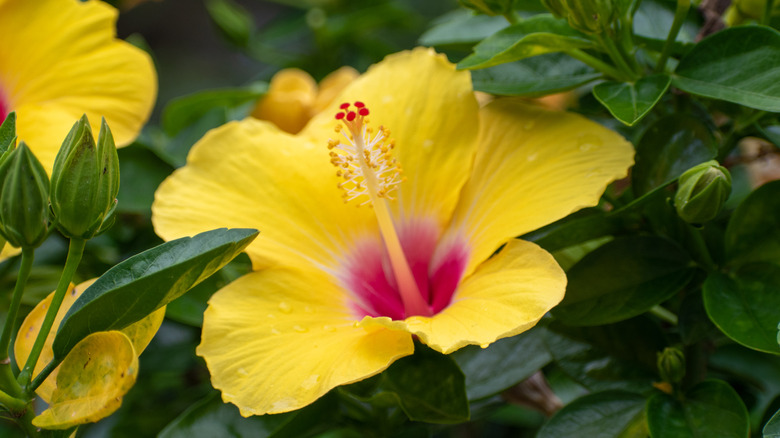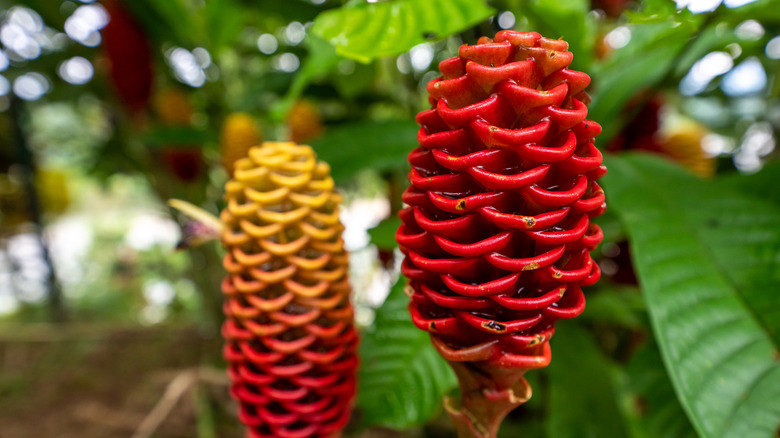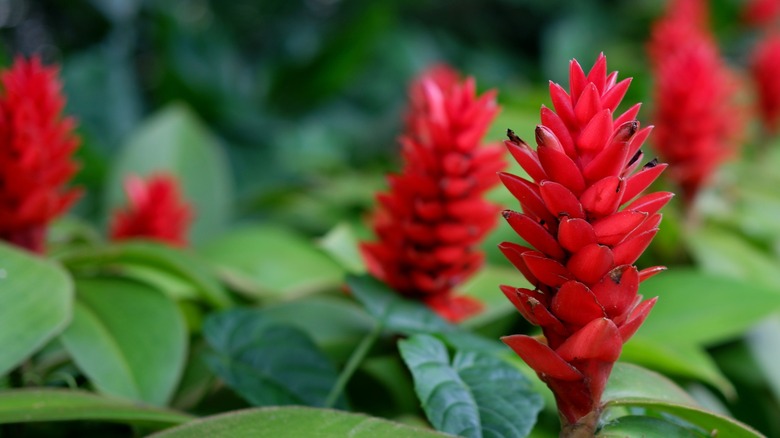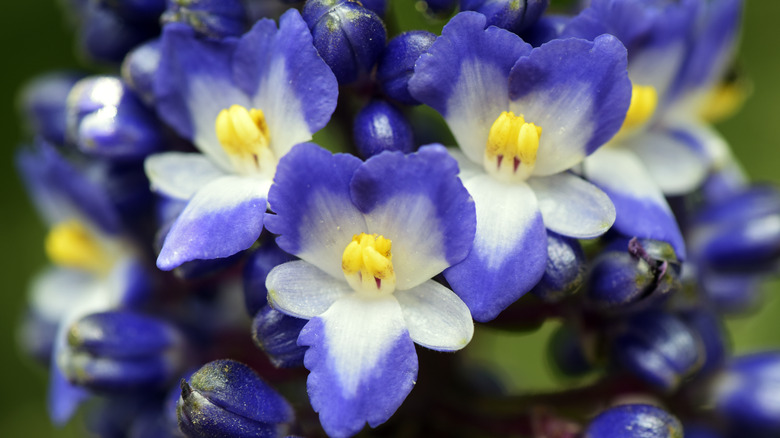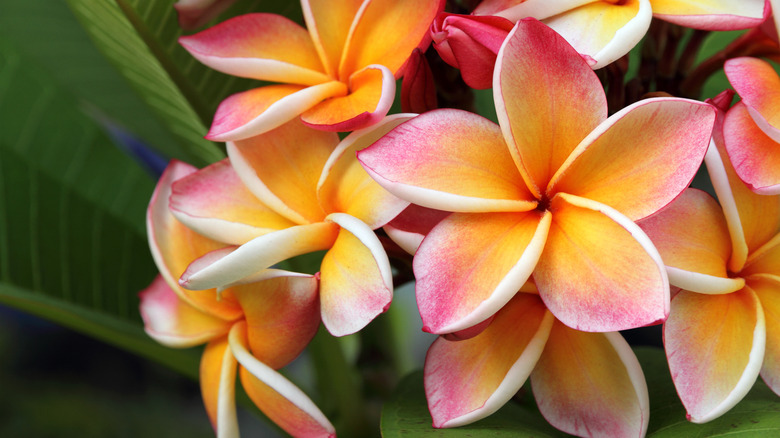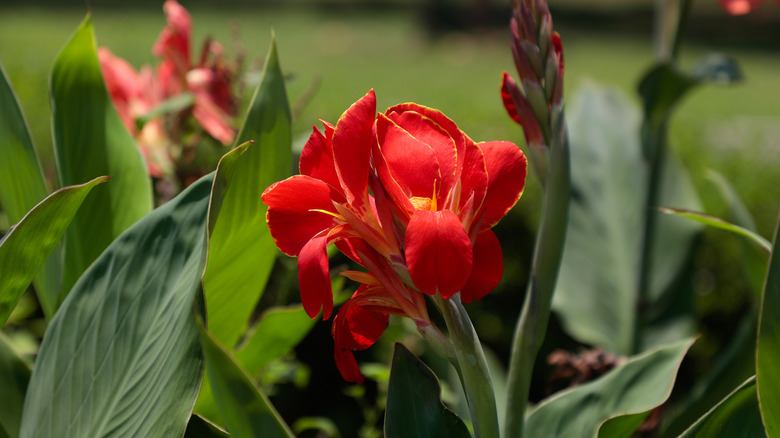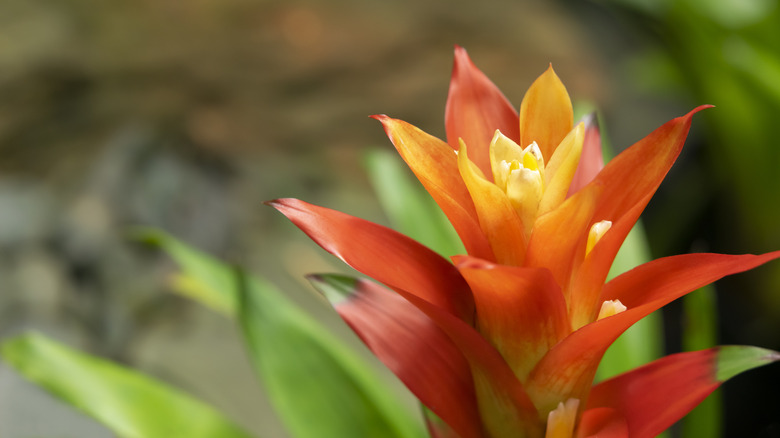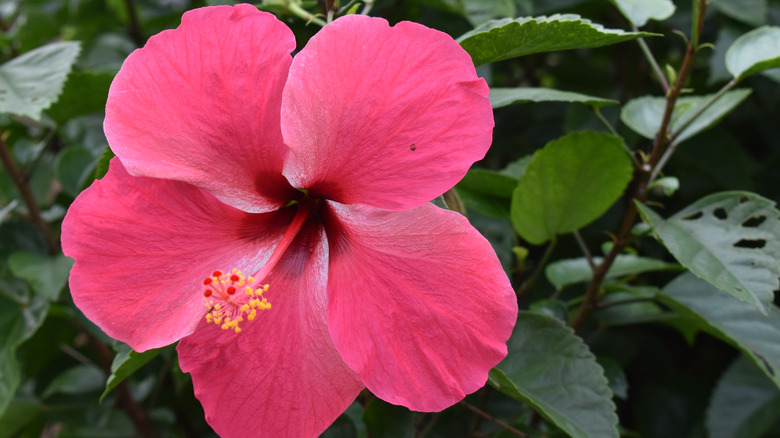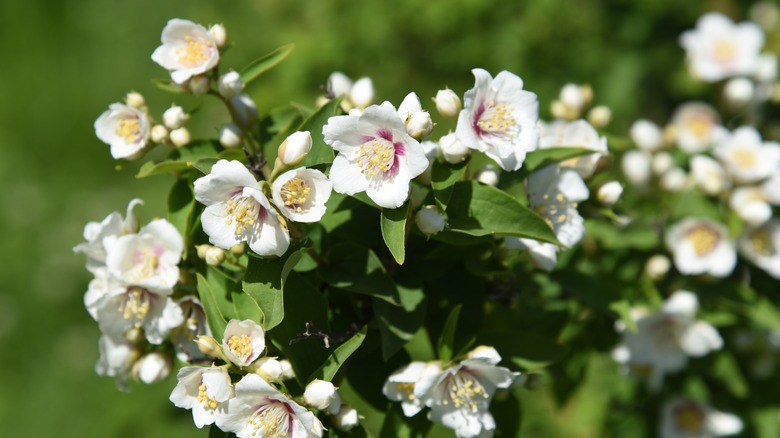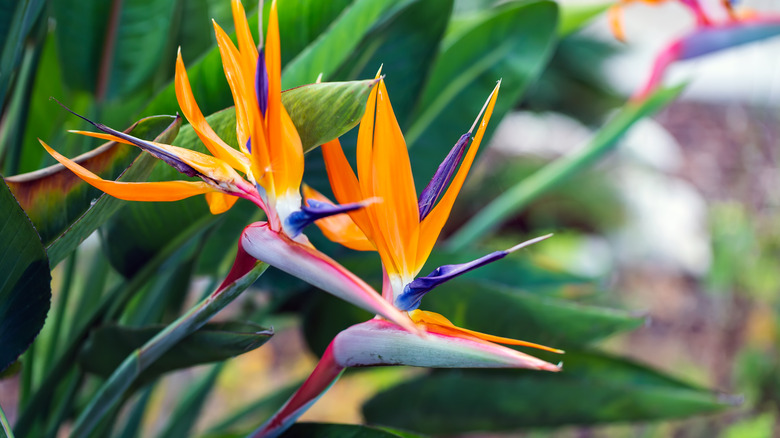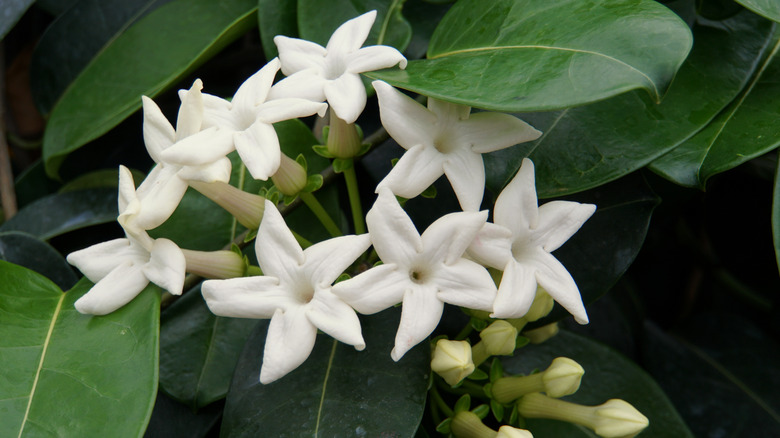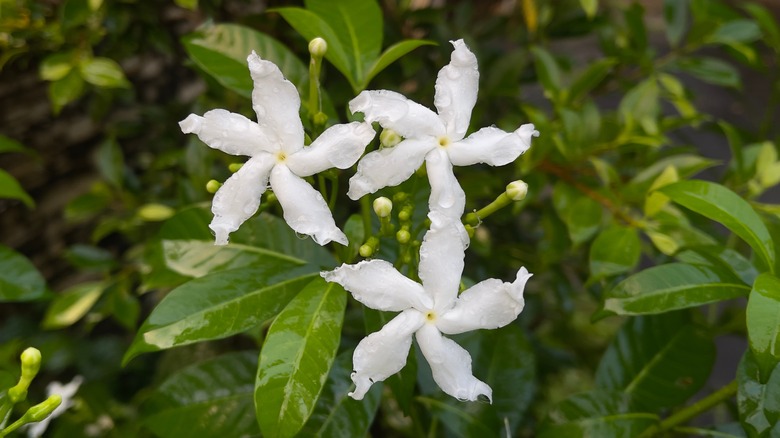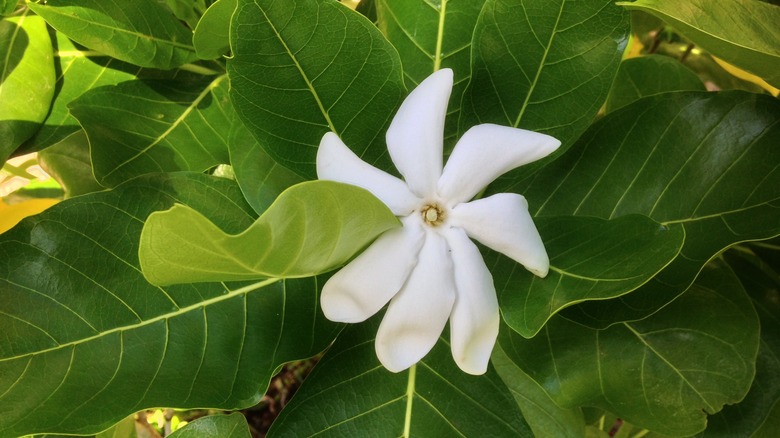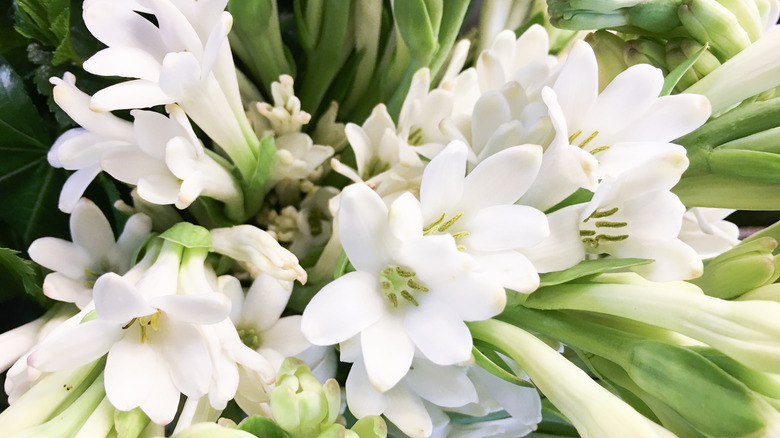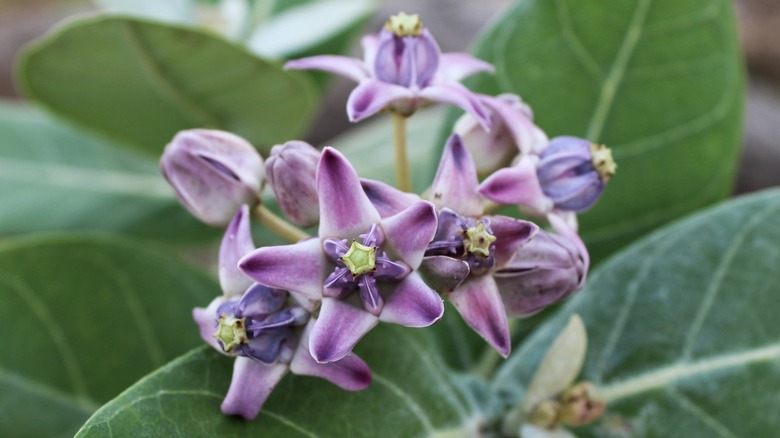Tropical Flowering Plants You Can Propagate From Cuttings
If you live in a cold climate area, there's nothing like bringing a bit of island life into your home. Even if you don't live in a location that has four very different seasons, propagating tropical flowering plants is a great way to add more color to your home and garden. Additionally, color in the garden is like ringing a dinner bell and alerting all the beneficial pollinators that the flower buffet is open. When it comes to propagating tropical plants from cuttings, not all are created equal. You can use pieces of the root, stem, node, or leaf to create a whole new plant, writes Missouri Botanical Garden. Depending on the type of flora, you can propagate it in water, substrate, or both.
It's important to keep in mind that when you're taking cuttings from woody-stemmed plants, you should remember to cut at an angle. The Laidback Gardener notes that the typical angle is around 45 degrees, but in reality, both 60 and 90-degree angles work fine, too. This type of cut provides more surface area for rooting, per Chicago Botanic Garden. If you cut horizontally, just make sure to trim your cutting at an angle and then dip it in rooting hormone powder before adding it to your potting soil.
So what types of tropical flowers can you propagate? The answer is more than you think. And it's not that hard, so if you're looking to create your own personal jungle, the time to start is now.
1. Ginger
Ginger is one of the easiest plants to propagate. There are over 1,600 different species of Zingiberaceae, all of which produce beautiful flowers. They are all edible, except wild ginger, which can cause kidney failure. (They're not invited to the party.) Turmeric and galangal are also part of the ginger family. To propagate, find a thumb of ginger that has the nodes on it. Cut the piece into ½-inch slices (a node on each), bury them in well-draining soil, and after a week or two, you'll start to see a little green sprout.
2. Red torch ginger
Red torch ginger is not for container gardening, so bear that in mind when making your cuttings. This particular ginger is known to reach 17 feet or more and boasts bold reddish-orange flowers. In culinary use, it has a very citrusy taste that does well at masking sour or fishy flavors. Like all rhizomes, red torch is pretty simple to propagate. You remove a node, dust it with fungicide, and plant it 2 inches deep in potting soil. This particular variant likes temperatures above 50 degrees Fahrenheit, limited wind, and partial shade to full sun.
3. Hawaiian blue ginger
Although it looks like a member of the Zingiberaceae family, Hawaiian blue ginger is actually related to the spiderwort plant. It prefers to live in partial to fully shaded areas and produces flowers year-round. To make a blue ginger offspring, cut the tips of the stems, leaving three leaves at the top of each cutting. Roll the bottom in hormone powder and plant it in a well-draining substrate. Make sure that it's watered, then seal it inside a plastic bag. It should show signs of growth in about six weeks.
4. Plumeria
Also known as frangipani, plumeria comes in a variety of different colors and scents. It goes dormant in the winter and loses all of its leaves. Once you've obtained a piece, leave it out of the sun so it can callus over, but not dry out. Be sure to wash your hands thoroughly, should you get any sap on them, because it's poisonous if ingested. (Plus, it's uber sticky.) This is a plant that can grow in soil or water. It just needs to have fertilizer or root growth hormone to make sure it grows big and strong.
5. Canna lily
Canna lilies come in all different rainbow hues, from pink to salmon, red to orange, yellow, purple, and blue. They're the main food source for the larvae of the Brazilian Skipper butterfly, who lays its eggs on the leaves so that its offspring can feast as soon as they hatch. Canna lilies are rhizomes, so you just need to break apart the tubers and transplant one of the "bulbs" into a 4-inch pot. Keep them in an area that's in full sun and protected from the elements.
6. Bromeliad
Bromeliads are beautiful once they bloom, producing an electric pink, orange, or yellow flower. Then they die. Luckily, these epiphytic plants have kids before they pass on. Sort of. These offshoots are called "pups" and are exact clones of the mother plant. You can safely remove and transplant them once they've reached ⅓ to ½ of their mother's size. Don't worry if there aren't any roots on your baby bromeliad plants. They don't need them and will eventually produce their own. Dip the ends in rooting hormone and fungicide and plant them in a 4-inch pot. They prefer warm climates.
7. Hibiscus
There are over 200 varieties of this edible flower, with colors ranging from red to yellow, pink, white, orange, and purple. For propagation, take a 4 to 6-inch cutting from new growth or soft wood, removing everything but the top set of leaves. Trim the bottom up to the node, dip it in rooting hormone, and place it in well-draining soil. Put a plastic bag over the cutting, taking care that nothing touches the leaves. Keep your baby hibiscus in partial shade with moist soil. It should root in around eight weeks.
8. Mock orange
The leaves and flowers of this fragrant shrub contain saponin compounds, which, when added to water, can actually make a lather that can be used for soap. There are at least 60 different varieties of this fragrant flora, and all of them smell divine. You're going to want to take your cuttings in the morning when the plant is most hydrated. Make sure that you're clipping below the last leaf node and using new or soft growth. Dip it in root hormone and plant it in a 4-inch pot using a loose substrate. Keep it out of direct sunlight.
9. Bird of paradise
This native of South Africa is also called a Crane Flower, because of the shape of its plumage. It can reach over 30 feet tall. To propagate, you'll need to carefully separate one bulb from the mass of tubers, making sure there's at least one fan (leaf) attached. Be sure to work carefully and try to keep the roots intact. Sprinkle growth hormone on the rhizome and plant it in any well-draining soil (birds of paradise aren't picky when it comes to substrate). Expect it to root in one to two weeks.
10. Stephanotis
This tropical vine grows clusters of small white flowers that are incredibly sweet. Its name is derived from the Greek Stephanos, meaning "crown," and otis, meaning "ear." This name supposedly came to fruition because the flower stamens resemble a certain part of the ear anatomy. Clip a 4 to 6-inch piece of vine right under a node and dip it in rooting soil. Make sure that the soil is moist and drains well. It should root in six to eight weeks. You can also clip under the node and put it in water along with liquid plant food.
11. Gardenia
This shrub produces sweet-smelling white flowers and can grow over 45 feet tall. It belongs to the Rubiaceae family (otherwise known as the coffee plant). Gardenia cuttings can take up to six weeks to show root growth, but they're pretty easy to propagate in water. Remove all but two leaves from the uppermost portion of the cutting and then dip it in rooting hormone. Fill a glass with water, making sure that about 2 inches of the plant are fully submerged. Use a clothespin to keep it from touching the bottom of the glass.
12. Pikake
Symbolizing romance and love, the word pikake is Hawaiian for "peacock." Outside the island of Hawaii, this aromatic white flower is actually known as jasmine. That being said, it was Princess Kaiulani who was responsible for naming her favorite flower after her favorite bird, the peacock. Choosing soft or green wood, make sure the cutting is done right below a leaf node and is 4 to 6 inches from the stem of the shrub. Remove most of the leaves to ensure even growth, dip the tip in rooting hormone, and plant it in pre-moistened soil.
13. Tuberose
Tuberose blooms some of the most fragrant and sweet flowers in the flora world. They're relatives to both yucca and agave and only bloom their bright white (or pink) cluster flowers at night. Tuberose is not found in the wild (what is known as a cultigen) and was created by the ancient Aztecs. This fragrant rhizome spreads quickly by producing bulbs, so once you've nestled the tuberose nubbin underneath some potting soil, just water it, keep it warm, and let it do its thing.
14. Crown flower
Also known as giant milkweed, this is a large tropical shrub that doesn't get dramatic if neglected. It produces fragrant white, purple, and/or blue star-shaped flowers (which look like mini crowns, hence the name) that are considered sacred by the Hindu people. The flowers were a favorite of Hawaii's last monarch, Queen Liliuokalani. It's also the favorite food for a different kind of royalty — the monarch butterfly. Take a cutting from a plant that's at least a foot tall. Put it in water with some liquid plant food and expect roots in a week or two.
